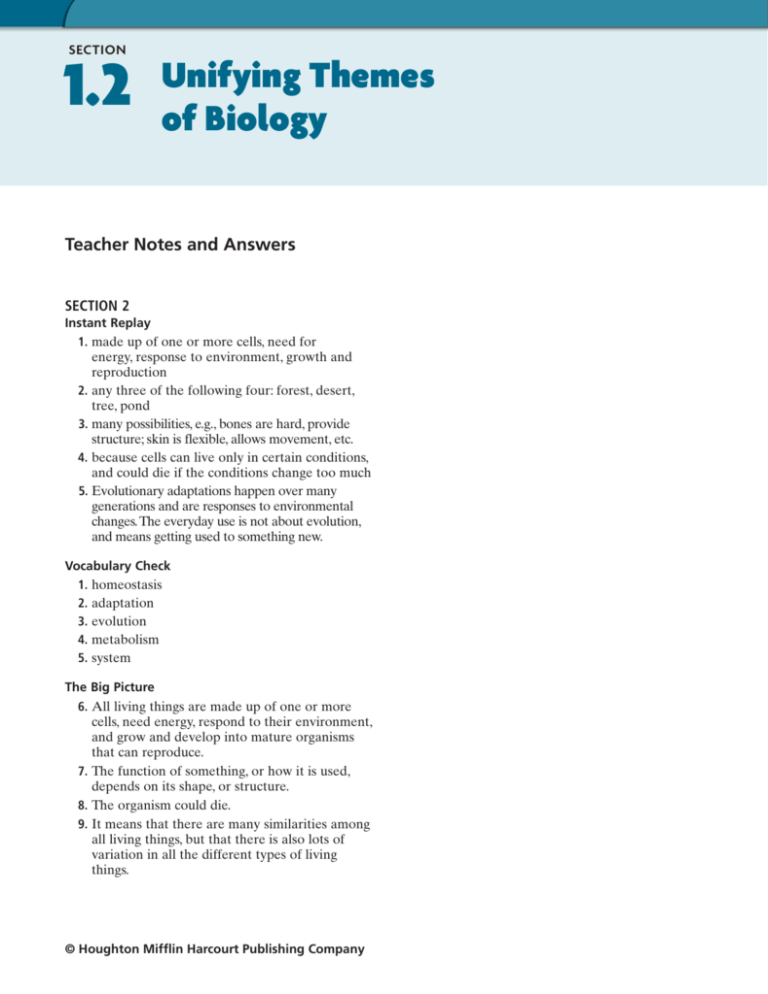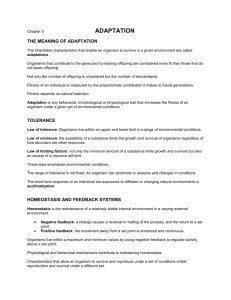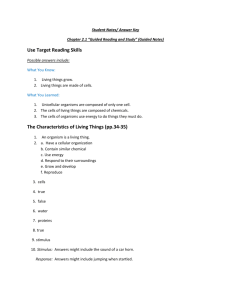Unifying Themes of Biology
advertisement

section 1.2 Unifying Themes of Biology Teacher Notes and Answers SECTION 2 Instant Replay 1.made up of one or more cells, need for energy, response to environment, growth and reproduction 2.any three of the following four: forest, desert, tree, pond 3.many possibilities, e.g., bones are hard, provide structure; skin is flexible, allows movement, etc. 4.because cells can live only in certain conditions, and could die if the conditions change too much 5.Evolutionary adaptations happen over many generations and are responses to environmental changes. The everyday use is not about evolution, and means getting used to something new. Vocabulary Check 1.homeostasis 2.adaptation 3.evolution 4.metabolism 5.system The Big Picture 6.All living things are made up of one or more cells, need energy, respond to their environment, and grow and develop into mature organisms that can reproduce. 7.The function of something, or how it is used, depends on its shape, or structure. 8.The organism could die. 9.It means that there are many similarities among all living things, but that there is also lots of variation in all the different types of living things. © Houghton Mifflin Harcourt Publishing Company section 1.2 Unifying Themes of Biology 4B, 7E, 10A, 10C, 11A Key Concept Unifying themes connect concepts from many fields of biology. When you hear the word theme, you might think of the music that starts your favorite TV show every week. Or you might think of something that happens over and over again. In biology, themes are ideas that come up time after time. They connect, or unify, different areas of biology. © Houghton Mifflin Harcourt Publishing Company All organisms share certain characteristics. Biology is the scientific study of all forms of life, or all types of organisms. An organism is any individual living thing. All organisms have some things in common. 1. Cells All organisms are made up of one or more cells. The cell is the basic unit of life. Many living things are made of just one cell. Other living things, such as humans, are made up of many cells. 2. Need for energy All organisms need a source of energy. Some organisms, such as plants, use energy from sunlight to make their own food. Animals get their energy by eating other organisms. Energy is used in metabolism. Metabolism is all of the chemical processes that happen in an organism. These chemical processes break down molecules and build up other molecules that an organism needs. 3. Response to environment Organisms react to light, temperature, touch, sound, and other parts of their environment. For example, plants grow toward light. The pupils of your eyes get smaller when you are in bright light. 4. Reproduction and development Members of a species must be able to reproduce, or make new organisms. The This example of an animal cell is new organisms, or offspring, must be able to grow and similar to many cells in your body. develop into mature* organisms that can have more offspring. When organisms reproduce, they pass on their genetic information to the offspring. The genetic information is in a molecule called DNA, or deoxyribonucleic acid. DNA contains molecular instructions for the growth and development of ­organisms. Highlight four characteristics that all organisms share. * Academic Vocabulary mature fully grown Interactive Reader 5 All levels of life have systems of related parts. Think about the different parts of a car—doors, tires, engine, seats, and so on. Even if you have all the different pieces of a car, it will not work unless all the pieces are put together in the right way. A car is a system. A system is a group of related parts that work together to make a whole. There are many systems in biology. Some systems are tiny. A single heart cell, for example, is a system. Different cell parts and different chemicals all work together to make the heart cell function. Your heart, blood, arteries, and veins all work together in another system, your circulatory system. An ecosystem is a biological system that includes living things, such as plants and animals, and nonliving things, such as water and rocks. A forest and a desert are both ecosystems. An ecosystem can also be a small area. A single tree or a pond is also an ecosystem. Circle three examples of ecosystems. Structure and function are related in biology. Think about a car again. The structure, or shape, of each car part is related to its function, or how it works. For example, the round shape of a tire allows it to roll. The treads help it not to slip. Structure and function are connected in living things, too. The structure of your ear allows you to hear—something that you cannot do with your knees or hands. The structure of your hands allows you to hold a pencil or a baseball bat—something you cannot do with your ears. Your sharp front teeth help you bite into food, and your flat back teeth help you grind up the food. Structure and function are connected on all levels. The structure of your nerve cells, for example, is different from the structure of your red blood Nerve cell cells and white blood cells. The differences in structure allow each type of cell to do its job. What is another example—not given above—of a relationship between structure and function in the human body? The structure of nerve cells allows them to send and receive electrical signals. The structure of blood cells is very different. Each cell’s structure affects its function. Blood cells 6 Holt McDougal Biology © Houghton Mifflin Harcourt Publishing Company The circulatory system and respiratory system work together to absorb oxygen from the air. Organisms must maintain homeostasis to survive in diverse environments. © Houghton Mifflin Harcourt Publishing Company How can people be outside when the temperature is below freezing, but still have a body temperature that stays around 37°C (98.6°F)? Although temperature and other conditions in the environment are always changing, the conditions inside of an organism usually stay the same. The ability of an organism to keep its internal conditions about the same is called homeostasis. It is very important that the conditions inside organisms stay the same, because cells can survive only in certain ranges of conditions. Changes in temperature, blood sugar, or other conditions in an organism’s body can be life threatening. Systems in your body help to keep you in homeostasis. If your body temperature gets higher than normal, for example, your body will start sweating to help you cool down. This is an example of negative feedback. Your body sends information that it is too hot; sweating helps return your temperature to its normal state. In negative feedback, a change in a system causes a response to return the system to normal. Behavior also helps to maintain homeostasis. If you feel too cold, for example, you may put on warmer clothes. Why is homeostasis important for survival? Evolution explains the unity and diversity of life. Evolution is the change in living things over time. Evolution is not a change in an individual. Instead, evolution is the change in the genetic makeup of a population—a group of individuals—of a species over time. Adaptation There is a lot of variation among the individuals in a species. Some variation can be inherited, or passed on to offspring through DNA. Some characteristics help an organism to survive and reproduce in a particular environment. An inherited characteristic that gives an advantage is called an adaptation. Organisms with an adaptation for a particular environment are more likely to survive and have offspring. Their offspring will also have the adaptation, and so they will be more likely to survive and reproduce. Over time, more individuals in the population will have the adaptation. This process is called natural selection. Interactive Reader 7 The meaning of the word adaptation in evolution is different from the common meaning of the word. For example, if you say that you are adapting to a new classroom or to a new town, you are not talking about evolution. Instead, you are talking about becoming familiar with something new. Evolutionary adaptations are changes that occur over many generations* in response to changes in the environment. Fish, birds, mushrooms, bacteria, and humans share many similarities. For example, they are all made of cells, and they all pass on genetic information through DNA. Their cells contain many similar structures with similar functions. These are examples of the similarities, or the unity, of life. Although living things share many similarities, they also have many differences. Fish, birds, mushrooms, bacteria, and humans live in different environments, get energy from different sources, and reproduce in very different ways. The diversity of life means the differences among living things. Evolution explains both the unity and the diversity of life. Over billions of years, living things have changed, resulting in a huge variety of species. Still, all species ­have things in common, because they all share common ancestors. There is both diversity, or differences, and unity, or similarities, in living things. What is the difference between the biological meaning of adaptation and the common meaning of adaptation? * Academic Vocabulary generation a single stage of offspring in the history of a family: You and your brothers and sisters are one generation; your parents are another generation. 8 Holt McDougal Biology © Houghton Mifflin Harcourt Publishing Company Unity and Diversity 1.2 organism cell metabolism DNA system Vocabulary Check ecosystem homeostasis evolution adaptation Mark It Up Go back and highlight each sentence that has a vocabulary word in bold. Choose the correct term from the list for each description. 1. conditions inside an organism do not change 2. an inherited characteristic that gives an organism an advantage 3. change over time of the genetic makeup of a population 4. All organisms use energy for , which is the breakdown and buildup of molecules necessary for life. 5. a group of parts that function as a whole © Houghton Mifflin Harcourt Publishing Company 1.2 The Big Picture 6. What characteristics are shared by all living things? 7. How are structure and function related in living things? 8. What could happen if an organism could not maintain homeostasis? 9. What does it mean that there is both unity and diversity of life? Interactive Reader 9








